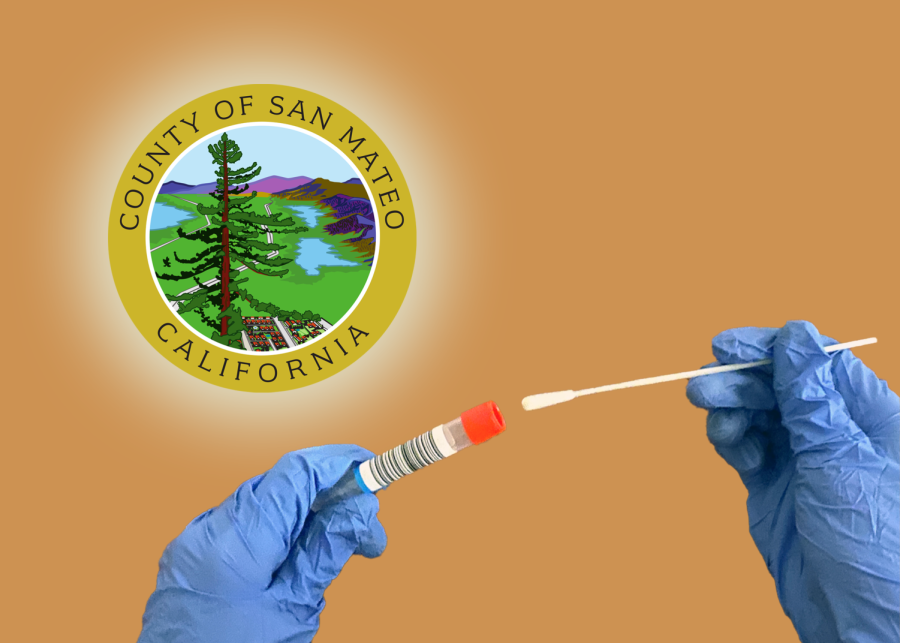Coming back from winter break, the Omicron variant of COVID-19 left many students anxious about their return to school. With the rise of at-home test shortages in pharmacies and long lines at in-person test centers, worries may have continued piling on.
San Mateo County, however, offered a solution. They unveiled their new COVID-19 testing plan in a press release on Jan. 5.
More PCR testing, which is considered more accurate than at-home testing according to an article by NPR, is a substantial portion of the plan. One new PCR testing facility, run by Virus Geeks, has been opened at the San Mateo County Event Center as of Jan. 7.
Additionally, some sites are changing their schedule to stay open longer during these difficult times. Among these is the testing site at Ted Adcock Community Center, located in Half Moon Bay, which is increasing from one day per week to three. They are also making more appointments available on Wednesdays. The test site at the College of San Mateo is also increasing their hours, from five to eight hours per day, to meet the oncoming demand.
Rapid antigen testing also plays a part. Starting on Jan. 10, up to 500 rapid antigen tests will be offered to those with appointments at the county’s San Bruno testing location, which is run by Bay PLS. In addition, San Mateo County will be purchasing 50,000 at-home COVID-19 testing kits to distribute to their most impacted and at-risk citizens, as well as first responders.
According to Preston Merchant, the Communications Officer at San Mateo County Health, such a plan is necessary, especially now that the Omicron variant is so prevalent.
“We are seeing that [Omicron] seems to be less severe, but its transmissibility is a real problem. That means [that] peoples’ health is at risk, but also, with the needs for isolation and quarantine, that a lot of people are going to be out of work and out of school, not able to do the jobs and the functions that they have been doing,” Merchant said. “Testing is one of the resources that helps blunt some of that effect.”
But now that everyone is returning to their jobs and school there is more demand, posing difficulties for testing capacity in the county.
“The holidays, the travel, and the reopening of school put pressure on our systems, and it has created a demand for even more testing,” Merchant said.
However, the testing systems aren’t the only things feeling the pressure.
Carlmont students and staff are also anxious about being back on campus, especially with so many cases of COVID-19 since the return to the classroom. Elizabeth Kao, a junior, expressed her worries about being back at school, mainly due to the Omicron variant.
“In terms of school and having so much interaction there, it may not be the best idea, at least right now,” Kao said. “[COVID-19 is] so contagious, and people are catching it left and right at school.”
After hearing about the new testing plan, some of her worries were eased, at least partially.
“I think this plan will help to a certain extent…The testing would be helpful, especially since it’s difficult to get an at-home testing kit right now,” Kao said. “But, even though there’s testing, there’s still going to be a lot of positive cases.”
According to Sequoia Union High School District’s COVID-19 dashboard, Carlmont reported 112 students who tested positive between Jan. 3 and Jan. 7. Jarrod Harrison, a history teacher at Carlmont, also expressed his uneasiness over the current situation, especially returning to school.
“I was scared when I saw the numbers before the first day back on the fourth, and I was unhappy that the district didn’t ensure the students and staff had the self-tests before school reopened. Once school reopened and we got through the first week back, I became more comfortable,” Harrison said. “It seems that the number [of cases] will continue to grow, but right now, they are not too bad; I am fairly confident since I have been vaccinated, but we shall see.”
Harrison is hopeful that the county’s new options will be helpful and explained that it might help control the number of cases at Carlmont with more access to tests, at least in the weeks to come. Regardless, he didn’t see how it would significantly change his own situation.
Harrison said, “I think everyone just needs to be cautious so we can ride this wave out.”























